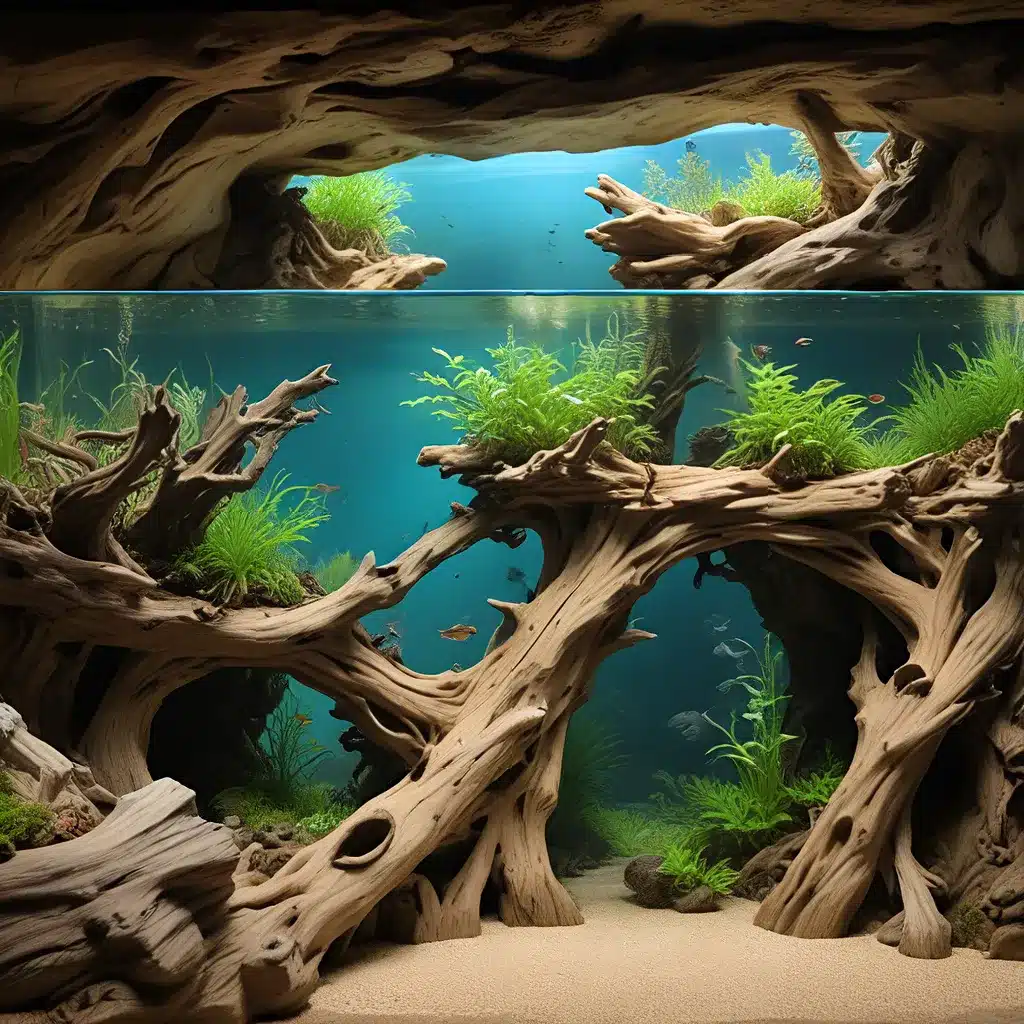
Embracing the Natural Aesthetic in Aquarium Design
As aquarium enthusiasts, we often find ourselves drawn to the captivating beauty and tranquility of natural aquatic environments. Whether it’s the lush vegetation, the intricate rock formations, or the mesmerizing flow of the water, the inherent elegance of nature has a profound influence on our aquarium designs. One of the most striking and functional elements we can incorporate into our aquascapes is the use of natural driftwood to create calming, cave-like structures that mimic the hidden refuges found in the wild.
The Importance of Providing Hiding Spots for Aquarium Inhabitants
Fishes, shrimps, and other aquatic creatures have an innate need for secure hiding spots within their environment. In the natural world, these shelters offer protection from predators, a place to rest, and even zones for spawning and breeding. By recreating these natural features in our aquariums, we can not only enhance the aesthetic appeal of our setups but also cater to the specific behavioral and physiological needs of our aquatic inhabitants.
Driftwood Caves: A Versatile and Functional Aquascaping Element
Driftwood is a versatile and visually striking material that can be used to create a wide range of aquascaping features, including the captivating driftwood caves that mimic the hidden nooks and crannies found in natural aquatic habitats. These wooden structures not only provide a sense of depth and three-dimensionality to your aquarium but also offer numerous benefits to your aquatic life.
Hiding and Resting Spots
One of the primary functions of driftwood caves is to offer secure hiding and resting spots for your fishes and invertebrates. Many species, such as dwarf cichlids, loaches, and shrimp, thrive in environments where they can retreat from view, reducing their stress levels and promoting overall well-being. By incorporating strategically placed driftwood caves, you can create a sense of security and natural behavior in your aquarium inhabitants.
Spawning and Breeding Grounds
In addition to providing hiding spots, driftwood caves can also serve as ideal spawning and breeding grounds for certain species of fishes. Some fish, such as Corydoras catfish and certain killifish, prefer to deposit their eggs in protected, dimly lit areas, often utilizing the nooks and crannies of driftwood structures. By creating these natural-looking retreats, you can encourage and facilitate the natural breeding behaviors of your aquarium inhabitants.
Aesthetic Appeal and Aquascaping Versatility
Beyond the functional benefits, driftwood caves also offer a stunning visual appeal that can enhance the overall aesthetic of your aquarium. By arranging the driftwood in a way that mimics the natural formations found in rivers, streams, and flooded forests, you can create a captivating and immersive underwater landscape. The organic shapes and textures of the wood can seamlessly integrate with other aquascaping elements, such as rocks, plants, and substrate, to craft a harmonious and visually striking aquarium design.
Considerations for Incorporating Driftwood Caves
When incorporating driftwood caves into your aquarium design, there are several important factors to consider to ensure the overall success and well-being of your aquatic ecosystem.
Selecting the Right Driftwood
Not all driftwood is created equal, and the selection of the appropriate type can greatly impact the longevity and stability of your aquarium setup. Opt for hardwood varieties, such as oak, maple, or chestnut, as they tend to be more durable and less prone to rapid decomposition. Avoid softwoods, like pine or cedar, as they may release tannins and other compounds that can be harmful to your aquatic inhabitants.
Preparing and Curing the Driftwood
Before incorporating the driftwood into your aquarium, it’s essential to properly prepare and cure the material. This involves thoroughly cleaning the driftwood, removing any loose bark or debris, and soaking it in water to leach out any potential contaminants or tannins. This process can take several weeks, depending on the size and density of the wood, but it’s a crucial step to ensure the long-term stability and water quality of your aquarium.
Anchoring and Positioning the Driftwood Caves
Proper placement and anchoring of the driftwood caves are crucial to maintaining the overall structure and functionality of your aquascaping. Consider using aquarium-safe adhesives or attaching the driftwood to a stable base, such as rocks or a substrate, to prevent it from shifting or collapsing over time. Strategically position the caves in a way that promotes natural water flow and creates a visually appealing and functional layout for your aquarium inhabitants.
Monitoring and Maintenance
Ongoing monitoring and maintenance of your driftwood caves are essential to ensure the long-term health and stability of your aquarium. Regularly inspect the structures for any signs of deterioration, and be prepared to replace or rearrange the driftwood as needed. Additionally, maintain proper water parameters, such as pH, temperature, and oxygen levels, to support the overall well-being of your aquatic ecosystem.
Conclusion
Incorporating natural driftwood caves into your aquarium design can be a powerful way to create a harmonious and functional underwater environment that caters to the specific needs of your aquatic inhabitants. By thoughtfully selecting, preparing, and positioning these wooden structures, you can enhance the aesthetic appeal of your aquarium while providing your fishes and invertebrates with the hiding spots, spawning grounds, and overall sense of security they require to thrive. With a little planning and attention to detail, you can unlock the true potential of your aquarium and cultivate a captivating and naturalistic underwater oasis.

